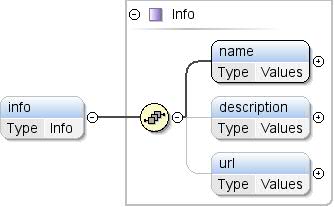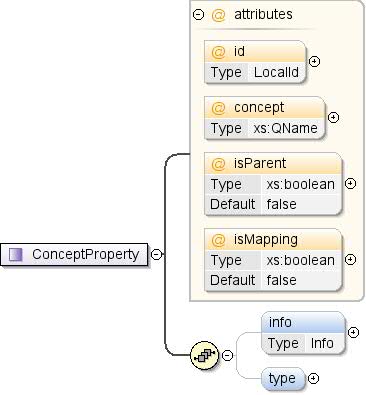कॉम्पोनेंट: Conceptप्रॉपर्टी
संग्रह की मदद से व्यवस्थित रहें
अपनी प्राथमिकताओं के आधार पर, कॉन्टेंट को सेव करें और कैटगरी में बांटें.
| नाम-स्थान |
http://schemas.google.com/dspl/2010 |
| एनोटेशन |
कॉन्सेप्ट प्रॉपर्टी के बारे में टेक्स्ट के तौर पर जानकारी. |
| डायग्राम |
 |
| टाइप |
जानकारी |
| प्रॉपर्टी |
| सामग्री: |
जटिल |
| मिनट समय: |
0 |
|
| मॉडल |
name , description{0,1} , यूआरएल{0,1} |
| बच्चे |
ब्यौरा, name, url |
| इंस्टेंस |
<info>
<name>{1,1}</name>
<description>{0,1}</description>
<url>{0,1}</url>
</info>
|
| स्रोत |
<xs:element name="info" type="Info" minOccurs="0">
<xs:annotation>
<xs:documentation>Textual information about the concept property.</xs:documentation>
</xs:annotation>
</xs:element>
|
| नाम-स्थान |
http://schemas.google.com/dspl/2010 |
| एनोटेशन |
कॉन्सेप्ट प्रॉपर्टी का डेटा टाइप. |
| डायग्राम |
 |
| प्रॉपर्टी |
| सामग्री: |
जटिल |
| मिनट समय: |
0 |
|
| विशेषताएं |
|
| स्रोत |
<xs:element name="type" minOccurs="0">
<xs:annotation>
<xs:documentation>The data type of the concept property.</xs:documentation>
</xs:annotation>
<xs:complexType>
<xs:attribute name="ref" type="DataType" use="required"/>
</xs:complexType>
</xs:element>
|
कॉम्प्लेक्स टाइप: Conceptप्रॉपर्टी
| नाम-स्थान |
http://schemas.google.com/dspl/2010 |
| एनोटेशन |
किसी कॉन्सेप्ट की प्रॉपर्टी (उदाहरण के लिए,
शहर). |
| डायग्राम |
 |
| इस्तेमाल करने वाले |
|
| मॉडल |
जानकारी{0,1} , टाइप{0,1} |
| बच्चे |
जानकारी, टाइप |
| विशेषताएं |
| QName |
टाइप |
तय |
डिफ़ॉल्ट |
इस्तेमाल करें |
टिप्पणी |
| सिद्धांत |
xs:QName |
|
|
ज़रूरी नहीं |
वैल्यू से मेल खाने वाले कॉन्सेप्ट का रेफ़रंस
प्रॉपर्टी का इस्तेमाल किया जा सकता है. अगर प्रॉपर्टी किसी प्रकार के बारे में बताती है, तो
दिए गए कॉन्सेप्ट के टाइप से मेल खाना चाहिए.
बाहरी सिद्धांत इस रूप में होना चाहिए
"prefix:other_Concept_id", जहां "prefix" इससे मेल खाता है
बाहरी डेटासेट के नेमस्पेस के लिए इस्तेमाल किया गया प्रीफ़िक्स (एक्सएमएल देखें
नेमस्पेस). |
| आईडी |
LocalId |
|
|
ज़रूरी नहीं |
कॉन्सेप्ट प्रॉपर्टी का आईडी. यह पहचानकर्ता होना चाहिए
यूनीक होनी चाहिए. (एट्रिब्यूट और प्रॉपर्टी में). कॉन्टेंट बनाने
अगर कॉन्सेप्ट प्रॉपर्टी दी गई है, तो आईडी को हटाया जा सकता है. इसमें
केस, एक आईडी स्पष्ट रूप से
में बताया गया है. उदाहरण के लिए <property
concept="geo:country"/> <property
id="country"
concept="geo:country"/> |
| isMapping |
xs:boolean |
|
गलत |
ज़रूरी नहीं |
अगर सही है, तो इस प्रॉपर्टी में किसी कॉन्सेप्ट का रेफ़रंस होना चाहिए, और
यह प्रॉपर्टी
दिया गया है. रेफ़र की गई सभी फ़ाइलों का हर इंस्टेंस
इस कॉन्सेप्ट का संदर्भ इस
कॉन्सेप्ट शामिल है. |
| isParent |
xs:boolean |
|
गलत |
ज़रूरी नहीं |
अगर सही है, तो इस प्रॉपर्टी में किसी कॉन्सेप्ट का रेफ़रंस होना चाहिए, और
यह प्रॉपर्टी
कॉन्सेप्ट और उससे जुड़े कॉन्सेप्ट (उदाहरण के लिए, किसी महाद्वीप)
देश के हिसाब से). |
|
| स्रोत |
<xs:complexType name="ConceptProperty">
<xs:annotation>
<xs:documentation>A property of a concept (e.g., the country of a city).</xs:documentation>
</xs:annotation>
<xs:sequence>
<xs:element name="info" type="Info" minOccurs="0">
<xs:annotation>
<xs:documentation>Textual information about the concept property.</xs:documentation>
</xs:annotation>
</xs:element>
<xs:element name="type" minOccurs="0">
<xs:annotation>
<xs:documentation>The data type of the concept property.</xs:documentation>
</xs:annotation>
<xs:complexType>
<xs:attribute name="ref" type="DataType" use="required"/>
</xs:complexType>
</xs:element>
</xs:sequence>
<xs:attribute name="id" type="LocalId" use="optional">
<xs:annotation>
<xs:documentation>The id of the concept property. This identifier must be unique within the concept
(across attributes and properties).
The id may be omitted if the concept property is specified. In that case, an id is
implicitly created with value the local name of the referenced concept. For instance
<property concept="geo:country"/>
is equivalent to
<property id="country" concept="geo:country"/></xs:documentation>
</xs:annotation>
</xs:attribute>
<xs:attribute name="concept" type="xs:QName" use="optional">
<xs:annotation>
<xs:documentation>A reference to a concept that corresponds to the values of the property.
If the property specifies a type, then the type must match the type of the
referenced concept.
A reference to an external concept must be of the form "prefix:other_concept_id",
where "prefix" is the prefix used for the namespace of the external dataset
(see XML namespaces).</xs:documentation>
</xs:annotation>
</xs:attribute>
<xs:attribute name="isParent" type="xs:boolean" use="optional" default="false">
<xs:annotation>
<xs:documentation>If true, then this property must reference a
concept, and this property denotes a hierarchical
relationship between this concept and the referenced
concept (e.g., the continent of a country).</xs:documentation>
</xs:annotation>
</xs:attribute>
<xs:attribute name="isMapping" type="xs:boolean" use="optional" default="false">
<xs:annotation>
<xs:documentation>If true, then this property must reference a
concept, and this property denotes a mapping
(1-to-1) relationship between this concept and the
referenced concept. Each instance of the referenced
concept is referenced by at most one instance of
this concept.</xs:documentation>
</xs:annotation>
</xs:attribute>
</xs:complexType>
|
| नाम-स्थान |
कोई नेमस्पेस नहीं |
| टाइप |
DataType |
| प्रॉपर्टी |
|
| Facets |
| गिनती |
स्ट्रिंग |
|
| गिनती |
फ़्लोट |
|
| गिनती |
पूर्णांक |
|
| गिनती |
बूलियन |
|
| गिनती |
तारीख |
|
| गिनती |
सिद्धान्त |
|
|
| इस्तेमाल करने वाले |
|
| स्रोत |
<xs:attribute name="ref" type="DataType" use="required"/>
|
| नाम-स्थान |
कोई नेमस्पेस नहीं |
| एनोटेशन |
सिद्धांत प्रॉपर्टी का आईडी. यह आइडेंटिफ़ायर यूनीक होना चाहिए
(एट्रिब्यूट और प्रॉपर्टी, दोनों में). आईडी यह हो सकती है:
अगर कॉन्सेप्ट प्रॉपर्टी दी गई है, तो इसे छोड़ दिया जाता है. इस मामले में, आईडी
यह प्रॉपर्टी, बताए गए कॉन्सेप्ट के स्थानीय नाम की मदद से बनाई गई है.
उदाहरण के लिए <property Concept="geo:country"/> इससे मेल खाता है
<property id="country" के बराबर
concept="geo:country"/> |
| टाइप |
LocalId |
| प्रॉपर्टी |
| इस्तेमाल करें: |
ज़रूरी नहीं |
|
| Facets |
|
| इस्तेमाल करने वाले |
|
| स्रोत |
<xs:attribute name="id" type="LocalId" use="optional">
<xs:annotation>
<xs:documentation>The id of the concept property. This identifier must be unique within the concept
(across attributes and properties).
The id may be omitted if the concept property is specified. In that case, an id is
implicitly created with value the local name of the referenced concept. For instance
<property concept="geo:country"/>
is equivalent to
<property id="country" concept="geo:country"/></xs:documentation>
</xs:annotation>
</xs:attribute>
|
| नाम-स्थान |
कोई नेमस्पेस नहीं |
| एनोटेशन |
ऐसे कॉन्सेप्ट का रेफ़रंस जो
प्रॉपर्टी. अगर प्रॉपर्टी किसी टाइप के बारे में बताती है, तो टाइप,
दिया गया है. किसी बाहरी कॉन्सेप्ट के रेफ़रंस में यह ज़रूरी है
"prefix:other_concept_id" रूप में होगा, जहां
"प्रीफ़िक्स" बाहरी के नेमस्पेस के लिए इस्तेमाल किया जाने वाला प्रीफ़िक्स है
डेटासेट (एक्सएमएल नेमस्पेस देखें). |
| टाइप |
xs:QName |
| प्रॉपर्टी |
| इस्तेमाल करें: |
ज़रूरी नहीं |
|
| इस्तेमाल करने वाले |
|
| स्रोत |
<xs:attribute name="concept" type="xs:QName" use="optional">
<xs:annotation>
<xs:documentation>A reference to a concept that corresponds to the values of the property.
If the property specifies a type, then the type must match the type of the
referenced concept.
A reference to an external concept must be of the form "prefix:other_concept_id",
where "prefix" is the prefix used for the namespace of the external dataset
(see XML namespaces).</xs:documentation>
</xs:annotation>
</xs:attribute>
|
| नाम-स्थान |
कोई नेमस्पेस नहीं |
| एनोटेशन |
अगर सही है, तो इस प्रॉपर्टी में किसी कॉन्सेप्ट का रेफ़रंस होना चाहिए, और इस
प्रॉपर्टी इस कॉन्सेप्ट और
कॉन्सेप्ट (जैसे, किसी देश का महाद्वीप). |
| टाइप |
xs:boolean |
| प्रॉपर्टी |
| इस्तेमाल करें: |
ज़रूरी नहीं |
| डिफ़ॉल्ट: |
गलत |
|
| इस्तेमाल करने वाले |
|
| स्रोत |
<xs:attribute name="isParent" type="xs:boolean" use="optional" default="false">
<xs:annotation>
<xs:documentation>If true, then this property must reference a
concept, and this property denotes a hierarchical
relationship between this concept and the referenced
concept (e.g., the continent of a country).</xs:documentation>
</xs:annotation>
</xs:attribute>
|
| नाम-स्थान |
कोई नेमस्पेस नहीं |
| एनोटेशन |
अगर सही है, तो इस प्रॉपर्टी में किसी कॉन्सेप्ट का रेफ़रंस होना चाहिए, और इस
प्रॉपर्टी, इस कॉन्सेप्ट और
पढ़ें. रेफ़र किए गए कॉन्सेप्ट का हर इंस्टेंस
दिया गया है. |
| टाइप |
xs:boolean |
| प्रॉपर्टी |
| इस्तेमाल करें: |
ज़रूरी नहीं |
| डिफ़ॉल्ट: |
गलत |
|
| इस्तेमाल करने वाले |
|
| स्रोत |
<xs:attribute name="isMapping" type="xs:boolean" use="optional" default="false">
<xs:annotation>
<xs:documentation>If true, then this property must reference a
concept, and this property denotes a mapping
(1-to-1) relationship between this concept and the
referenced concept. Each instance of the referenced
concept is referenced by at most one instance of
this concept.</xs:documentation>
</xs:annotation>
</xs:attribute>
|
इसका इस्तेमाल करके बनाया गया
oXygen का एक्सएमएल एडिटर.
जब तक कुछ अलग से न बताया जाए, तब तक इस पेज की सामग्री को Creative Commons Attribution 4.0 License के तहत और कोड के नमूनों को Apache 2.0 License के तहत लाइसेंस मिला है. ज़्यादा जानकारी के लिए, Google Developers साइट नीतियां देखें. Oracle और/या इससे जुड़ी हुई कंपनियों का, Java एक रजिस्टर किया हुआ ट्रेडमार्क है.
आखिरी बार 2025-07-25 (UTC) को अपडेट किया गया.
[[["समझने में आसान है","easyToUnderstand","thumb-up"],["मेरी समस्या हल हो गई","solvedMyProblem","thumb-up"],["अन्य","otherUp","thumb-up"]],[["वह जानकारी मौजूद नहीं है जो मुझे चाहिए","missingTheInformationINeed","thumb-down"],["बहुत मुश्किल है / बहुत सारे चरण हैं","tooComplicatedTooManySteps","thumb-down"],["पुराना","outOfDate","thumb-down"],["अनुवाद से जुड़ी समस्या","translationIssue","thumb-down"],["सैंपल / कोड से जुड़ी समस्या","samplesCodeIssue","thumb-down"],["अन्य","otherDown","thumb-down"]],["आखिरी बार 2025-07-25 (UTC) को अपडेट किया गया."],[],["ConceptProperty defines a characteristic of a concept, with optional `info` and `type`. The `info` contains text about the property, including `name`, `description`, and `url`. `type` specifies the data type. Attributes include an optional `id` for unique identification, an optional `concept` to reference related concepts, `isParent` (hierarchical relationship), and `isMapping` (1-to-1 relationship), both booleans, defaulting to `false`. The `@ref` attribute is required for type and defines the data type of the referenced concept.\n"]]



